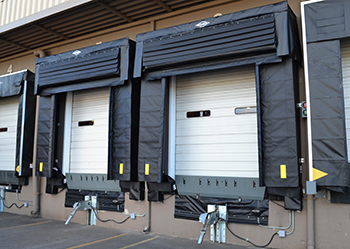Save Energy at the Loading Dock
 Facility managers are always exploring ways to tighten their belts and bolster their company’s bottom line. A growing number of industrial facilities are finding one path to savings runs through an often-overlooked area of their facility’s operations — its loading docks.
Facility managers are always exploring ways to tighten their belts and bolster their company’s bottom line. A growing number of industrial facilities are finding one path to savings runs through an often-overlooked area of their facility’s operations — its loading docks.
While they are a critical conduit between a facility and the materials going in and out every day, loading docks present multiple challenges to energy and safety. Fortunately, managers can significantly address these problems using a system of loading dock products — improving employee safety and protecting materials, while saving thousands of dollars a year in wasted heating and cooling cost expenditures.
Losing Energy & Money at the Loading Dock
The loading dock presents the greatest opportunity for energy loss and damage to goods. Any opening can allow conditioned air to leave and foreign contaminants like dust, water and even rodents to enter. Even when trailers are at the loading dock, gaps often exist between the trailer and the edges of the dock opening. Swing-open trailer doors usually lead to 1- to 2-inch gaps. While that might seem insignificant at first glance, it equates to a 2.5-square-foot hole at just one dock opening. Depending on the climate of the facility, this represents anywhere from $600 to $1,200 quite literally flying out the door every year. Extrapolate those figures over multiple dock doors, and the financial loss is significantly more profound.
The sides of the dock opening aren’t the only gaps in the building’s perimeter. Many facility managers forget about the “fourth side” of the dock — the bottom end, where the leveler, trailer, and dock seal or shelter all meet. Depending on the size of the opening, that gap could result in another $200 to $900 lost annually.
Contamination Concerns
Sealing all the gaps at each loading dock door can protect employees and products as well. Gaps between the loading dock wall and the trailer can let in dust, debris, rain and bugs. Exposure to these elements can damage products and equipment, and cause slips and falls, leading to even more profit-erosion.
Looking for Light
In almost all cases, the first rule of thumb is to look for light along the dock door perimeter — where there’s light coming through, there’s energy leaving the facility and an opportunity for contaminants to enter. These light leaks often appear on the sides and tops of trailers. If you can see daylight at your loading dock doors, there’s a gap to be filled — and you’ll need to source the right products to fit each type of gap. Remember, even the smallest, most seemingly harmless gaps can add up to hundreds of dollars in lost energy annually.
Sealing the Perimeter
Getting a consistent, gap-free seal along trailer sides, tops and corners as well as at the bottom of dock door openings is essential to creating an environmentally secure and energy-efficient dock. An effective system of sealing products starts with a dock shelter that is specifically designed to overcome the most difficult sealing challenges.
Dock shelter head curtains help seal gaps and create a seal at the top of the trailer. However, sealing and blocking out daylight completely can be a challenge, made worse at facilities that are serviced by trailers of varying sizes, where head curtains aren’t frequently adjusted correctly to reach lower trailers. Therefore, a head curtain that utilizes weight and gravity to create a solid connection with the trailer top is essential, as the weight is necessary to maintain a tight, consistent seal across the full width of the trailer as it bounces during loading and unloading. Also, the head seal must automatically adjust to a wide range of trailer heights without requiring pull ropes or other forms of manual adjustment. This type of shelter header essentially “does it all” and eliminates the need for an additional overhead rain diversion device.
Facility managers should also make sure their dock shelters provide a solid seal at trailer top corners, where the side curtains and head curtain come together. This area is notoriously difficult to seal and requires specially designed equipment to ensure an effective seal. On the sides of the trailer, keep the 2.5 cumulative square feet of opening created by exposed hinge gaps covered completely by hooks on the shelter side curtains.
Completing the Seal
While it is critical to effectively seals gaps at the top and along the sides of the dock opening, don’t forget the aforementioned “fourth side” — the bottom. Gaps typically exist below and around the leveler and dock bumpers, which present another challenge for energy costs and industrial hygiene.
Installing a seal under the leveler can offer a barrier against the elements on the facility’s exterior. Inside, lip corner seals, filler pads and other components keep the inside of the dock protected. Sealing under and around the leveler will help keep dirt, debris and refuse out of leveler pit and close gaps that allow dirt, dust and insects into the building. Sealing these gaps will also help reduce heat transfer through the steel leveler deck and — as on the other three sides of the dock opening — will help prevent heated or cooled air from escaping the building. Experts estimate that facilities can save up to $1,000 per year per dock position in total energy savings, depending on climate, by using under-leveler seals.
Mary Blaser is the director of marketing and business development for Rite-Hite Environmental Enclosures Corporation, a company that specializes in the manufacture, sale and service of loading dock equipment and more.
